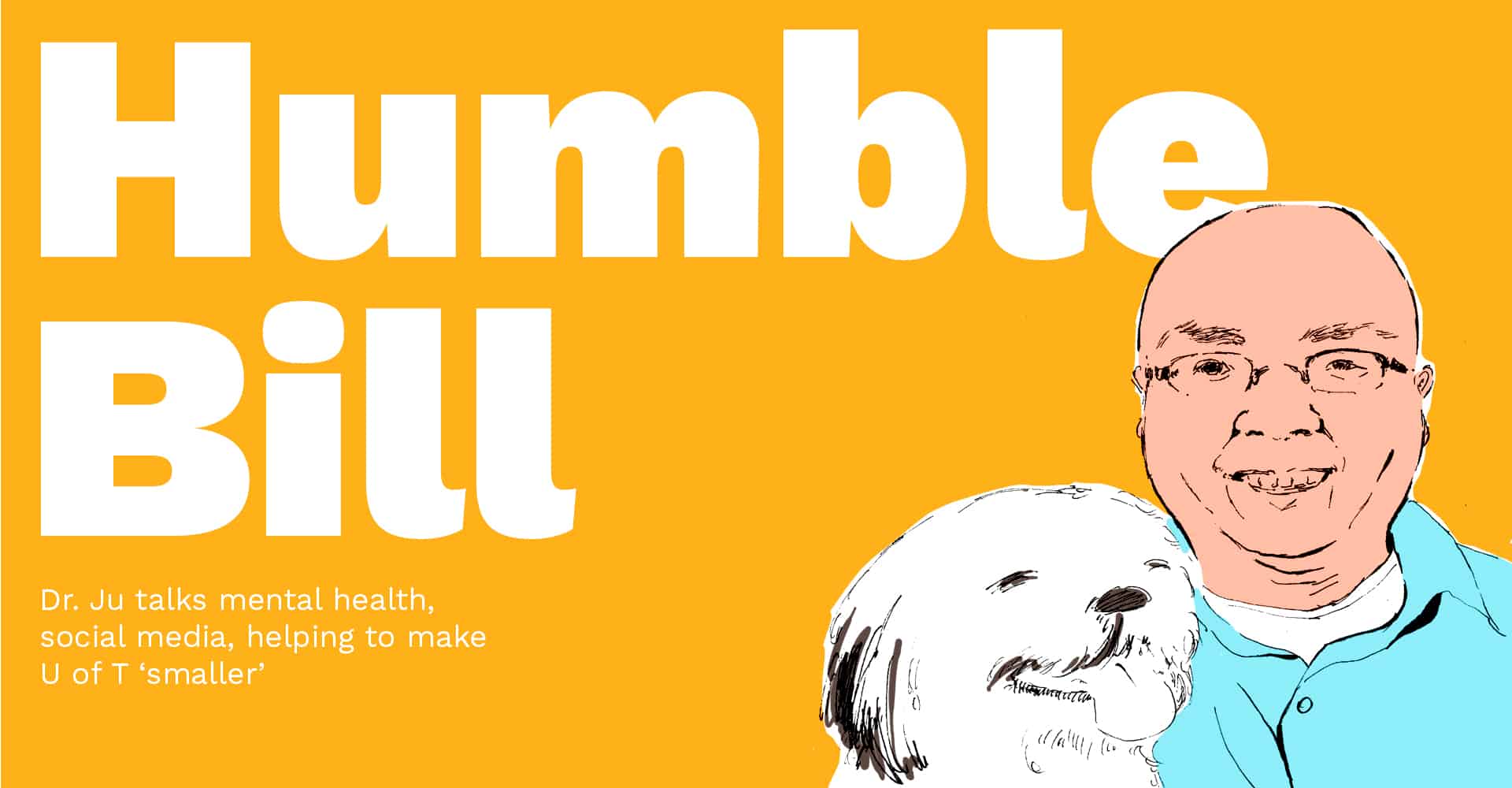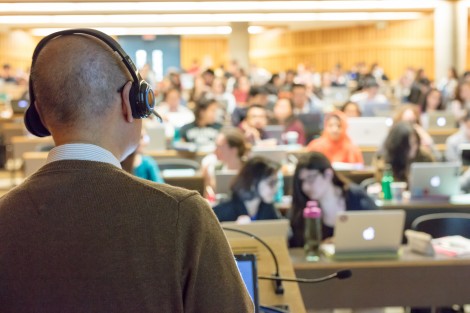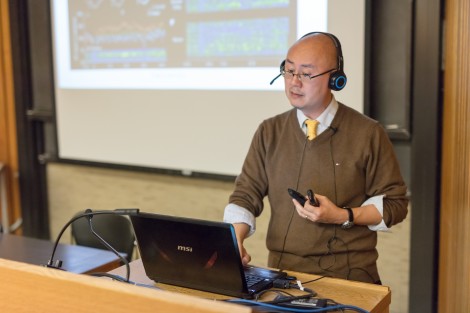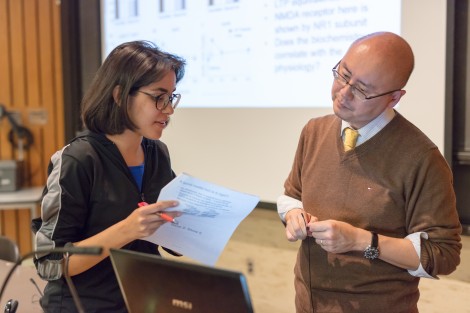[dropcap]D[/dropcap]r. William Ju — or as he likes to be called, ‘PBJ’ — is an Associate Professor in the Human Biology (HMB) Department. His focus is neuroscience, and he teaches intermediate level and specialized neuro classes, like HMB300 — Neurobiology of Behaviour.
Ju himself struggles with something that is widely affected by neurobiology: generalized anxiety. The experience and expertise that he brings students is not only academic but also personal.
Connecting with students
I first heard Ju speak in a physiology course, PSL300, last summer. He walked up to the platform, looked out at all of us, and began to explain that he was feeling really anxious. He pointed out that when he spoke in front of crowds, his anxiety levels rose and it was very difficult for him.
I had never heard a professor so candidly make a statement about mental illness, with which many students struggle daily, weekly, and sometimes even hourly.
In 2012, Maclean’s announced a “mental health crisis on campus.” As a student struggling with her own mental health problems, knowing that a professor was also struggling brought me hope that the stigma surrounding mental health was not only fading among students, but among the teaching stream as well.
As I got to know Ju over the intervening weeks, I learned about his use of social media with students, even receiving a ‘friend request’ on Facebook from him. He had taken the time to remember me from his class.
When the first midterm came along, he messaged me over Facebook inviting me to come into the department to help ease my anxiety. I went in and he took the time to go over the material I needed to know. He even mentioned that I was overwhelmed and at my limit of information.
What makes Ju so different from other professors? What made him decide to ‘friend’ me on Facebook, to reach out to me, and to mentor me?
I decided to ask him myself.
I travelled down the yellowing corridors of Wetmore Hall — past the photographs of years of alumni, to the tucked-away HMB Department.
No one is at the reception to greet me, but every time I walk in, a smiling face peeks around a corner and familiar students are greeted by their first names. When I walk in, I feel at home.
A true part of the HMB family, Ju greeted me with a smile, exclaiming he had just returned from a classroom, and his anxiety levels were rising due to malfunctioning technology.
He invited me to sit in his office and immediately I saw all the cards lined upon the window ledge with ‘Thank You’ written across the front. A pile of stickers sat to the side, ‘Neuroscience Ambassador’ emblazoned on them.
“I’m going to make a guarantee that I’m going to learn everyone’s names this semester,” he told me. “Don’t you always kind of like it when your prof knows who you are and knows you as a human being instead of just someone in the class?”
“U of T is kind of a really big school and the classes are really big and everyone knows it’s that way and everyone knows it’s a problem, so why doesn’t someone do something about it?” Ju questioned.
Acknowledging mental health
U of T is the largest university in Canada: 80,000 students are enroled in its three campuses. It is easy to get lost, to slip through the cracks. It can be uncomfortable for students to speak about their struggles, and when it comes to professors, some may not know where to turn. Paniz Bastan Hagh, a Neuroscience major, understands this.
“When I was going through a difficult time, both emotionally and academically, regardless of the fact that I wasn’t even a student of Ju’s yet, he replied to me quicker than even the department or my own professors at the time,” said Bastan Hagh, who is currently enroled in Ju’s HMB300 class.
“He eased my mind about all the concerns I had and was a huge help. After that, I realized I could rely on him,” Bastan Hagh continued.
Perhaps the reason Ju is so relatable to students, is that he does not hesitate to talk about his own experiences.
“I happen to talk a lot about social anxiety,” Ju explained. “And I think part of that is, I’m in neuroscience – we talk about mental health… It’s just a natural extension of what we talk about in the classroom.”
As mental health issues become more openly acknowledged — thanks to national initiatives like ‘Bell Let’s Talk’, which saw Canadian Olympic medalist Clara Hughes acting as an ambassador for mental health awareness — these issues are filtering through to academic institutions like U of T and the Centre for Addiction and Mental Health. Mental health awareness is simply starting to become part of the university’s discourse.
When I asked Ju if he feels like he’s made a difference for students, he laughed a little.
“I don’t know. I know it helps me to talk about it,” Ju said. “It makes me really nervous and anxious in a social situation, especially when students are looking to me for leadership and I kept ducking out of the room. I’d leave for a couple minutes, then come back again, and students were wondering what’s going on, and I had to tell them quite honestly.”
“At least for me, talking about it helps,” he continued. “If I have these kinds of issues and students are wondering, ‘That kind of behaviour is a little bit odd’… at least for those students, they may understand that behaviour a little bit better… They may see it in other students and have a little bit more [of an] open mind about it.”
Creating community with the CMT
Communication is only one strategy among many for dealing with anxiety. I learned about resiliency — and how U of T is helping to foster resiliency in students — at the Science as a Critical Practice: Preparing for Your Senior Year and Beyond conference on September 9.
Resiliency is a schema from which individuals can draw, in order to overcome challenges. To build resiliency, individuals must foster their own community by reaching out to others. A reciprocal relationship between students and professors goes a long way in accomplishing this.
I asked Ju about his methods of building resiliency, including the Course Management Committee (CMT), an initiative fostered by the HMB department to empower students. The CMT gives students responsibility over their own courses and a voice in the decision-making process.
Ju is adamant that he does not lead the CMT but rather guides students, ensuring they have input into their own courses.
CMT meetings include all students who wish to attend, and they cover any course issues, syllabi, and assignments. There is also a Facebook page for CMT members.
Not only does the CMT offer student connections, it also allows students to converse with professors outside of the classroom and gives them a platform to voice their concerns, including those regarding mental health issues.
“[We’ve] done the CMT for a number of years — this is why we get students who can come back and train, a form of pedagogy. They will go off and present what this experience is like and why students would want to do this or other profs want to do this.”
Ju is adamant that he is not the only other professor who takes these or similar inclusivity initiatives with his students. When I drop the word “champion,” he shakes his head emphatically.
“It’s very nice to hear, but the reality is, I’m not,” Ju said. “Often times you’ll hear about things because one person talks about it. It doesn’t mean that there are not other people who are interested in it.”
Social media presence
One major difference between Ju and other professors is his use of social media to communicate with students.
“I didn’t hear of anything close to [the CMT] before I enroled in his class and came upon his Facebook posts,” said Saberina Ahmed, a Neuroscience major. “It was refreshing.”
A study conducted in 2013 investigated this very topic, finding that professors’ Facebook profiles did indeed affect students’ perceptions of them. Those perceptions, either positive or negative, tended to be very strong.
As Ju stated, to what extent a professor may want to keep his or her private life truly private should have no bearing on that professor’s openness to students — and indeed, many U of T professors have an open door or open email policy. He may appear more accessible than most, simply because his social media presence is quite strong — he has over 4,500 Facebook friends.
“It eases a [student’s] mind when they know their professor actually genuinely understands and is willing to support their students,” Bastan Hagh said. “I really appreciate how he brings up his own mental health issues and tries to break the stigma towards mental health. It almost brought me to tears in my first class to hear about how much he cares for those of us who are going through a hard time.”
By making himself more available outside typical classroom time, office hours, or email, Ju has given rise to a community of students who not only reach out to him but also to each other. That community seems to be expanding.
While Ju may be a social media expert, his emphasis is always on classroom dynamics.
“It’s supposed to be about the students and how things work in the classroom that makes students feel like they are the main focal point,” he explained. “And I think this is an ongoing change in the way that we are doing things.”
So should professors put themselves out there? There is no right or wrong answer; it’s simply a matter of personal choice. Nevertheless, the fact remains that social media is one possible way of bringing lives closer together. Of the 80,000 or so students that attend U of T, many have probably formed meaningful connections this way.
Before the end of our interview, I glanced one last time around Ju’s office, taking note of the neuroscience paraphernalia, the dual monitors on his desk, and the lecture slides lighting the screens.
“Students are important and they should feel like they are important,” Ju said. “Hopefully any student that walks in and talks to [undergraduate administrators doesn’t] feel like, ‘They just want me out of here.’”
As if on cue, I heard laughter out in the hallway, the atmosphere easing up at the end of a long day.
Before I left Ju’s office, he added, “I don’t want [class] to be a stage version of Hamlet. I don’t want to be up there every week performing a soliloquy to you. I want it to be an ongoing discussion, and I want you to be involved.”
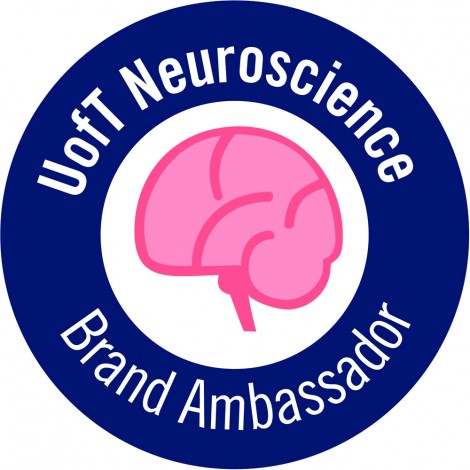 As a member of the CMT who’s engaged in social media discussions with Ju and my peers, I have also come to feel more like a part of a community — like U of T is my home. I have come to feel the care that Ju seeks to foster on campus.
As a member of the CMT who’s engaged in social media discussions with Ju and my peers, I have also come to feel more like a part of a community — like U of T is my home. I have come to feel the care that Ju seeks to foster on campus.
“I’m not paying tuition,” Ju expressed with a smile. “In theory, I work for you.”

